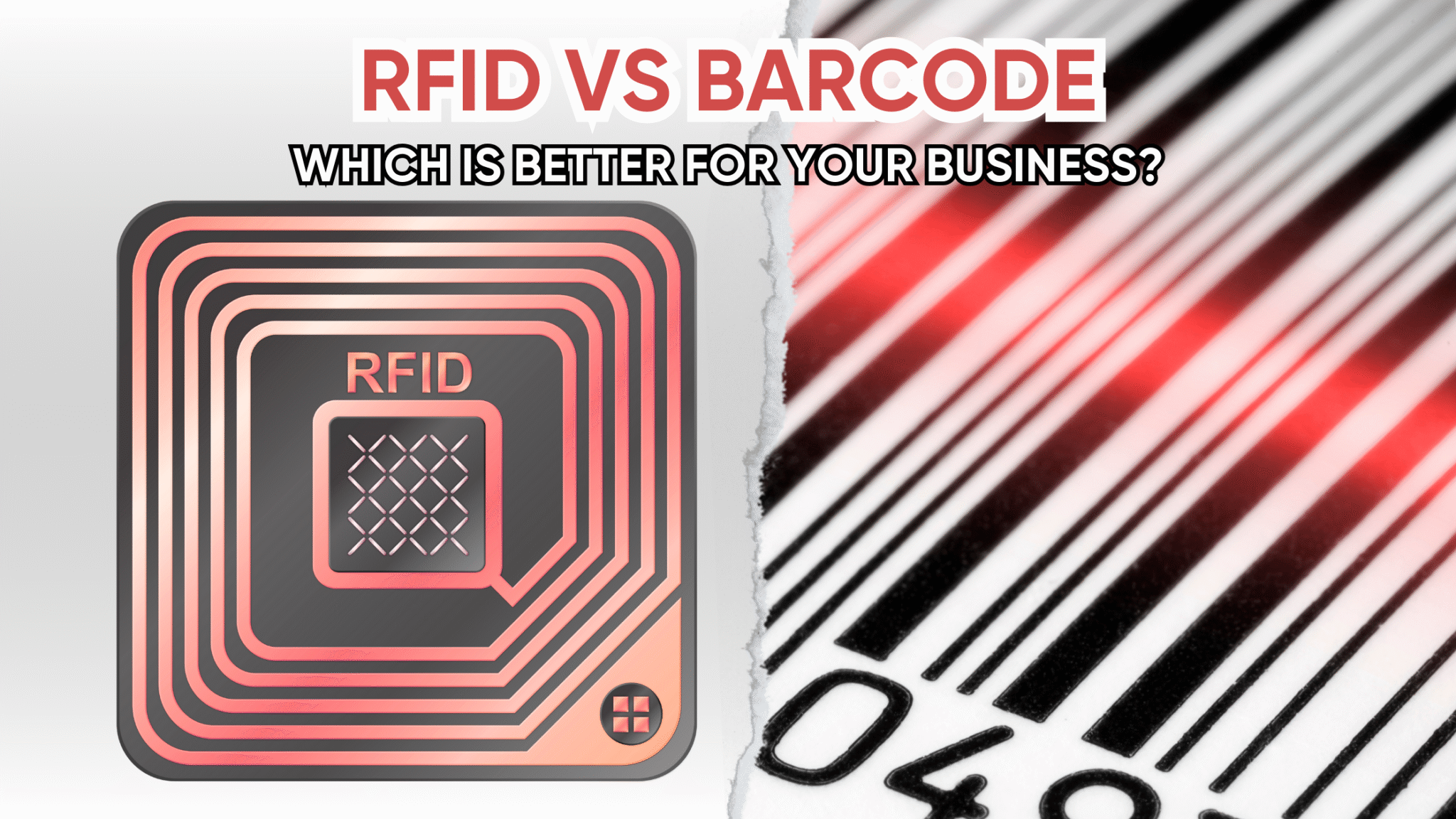Both RFID (Radio-Frequency Identification) and barcodes are used for tracking and identifying items, but they differ significantly in functionality, efficiency, and application.
In today’s fast-paced business world, efficient tracking and identification of assets, inventory, or products are critical for staying competitive. RFID (Radio-Frequency Identification) and barcodes are two widely used technologies that help businesses manage their operations, but they differ significantly in functionality, cost, and application. Whether you’re a retailer aiming to streamline inventory, a logistics provider tracking shipments, or a small business managing limited resources, choosing the right technology can transform your operations. This section compares RFID and barcodes to help you decide which is best for your business needs, exploring their features and industry-specific advantages.
RFID vs Barcode: Key Differences
RFID uses radio waves to wirelessly identify and track objects, offering a read range of up to 20 feet for passive tags and hundreds of feet for active tags, without needing line-of-sight. It supports bulk reading, stores dynamic data, and is durable in harsh environments, though it comes with higher costs (e.g., passive tags ~$0.10). Barcodes, on the other hand, rely on optical scanning, requiring line-of-sight and reading one code at a time, with a shorter range (a few inches to feet). They are cheaper and simpler but lack RFID’s automation and security features, like encryption. RFID excels in speed and scalability (e.g., Zara’s 15% inventory accuracy boost), while barcodes suit basic, low-cost tracking needs.
Here’s a clear comparison to help you understand which technology suits your business needs:
RFID vs Barcode: Difference at A Glance
| Feature | RFID | Barcode |
|---|---|---|
| Full Form | Radio-Frequency Identification | No specific full form; refers to a visual pattern of lines or shapes |
| Technology | Uses radio waves to wirelessly transmit data from tags to readers | Uses optical scanning of printed lines or patterns |
| Line of Sight | No line of sight required; tags can be read through materials like walls or packaging | Requires direct line of sight for scanning |
| Read Range | Up to 20 feet for passive tags, hundreds of feet for active tags | Typically a few inches to a few feet, depending on the scanner |
| Data Storage | Stores more data (e.g., product IDs, serial numbers, or dynamic info) | Limited to basic data (e.g., product code) |
| Read Speed | Can read multiple tags simultaneously (e.g., entire inventory in seconds) | Reads one barcode at a time, slowing down bulk scanning |
| Durability | Tags are durable, reusable, and can withstand harsh conditions (e.g., heat, moisture) | Labels can fade, tear, or become unreadable if damaged |
| Cost | Higher initial cost (passive tags ~$0.10, readers more expensive) | Lower cost (labels are cheap, scanners affordable) |
| Security | Supports encryption and access controls for secure data transmission | Limited security; barcodes can be easily copied or scanned |
| Applications | Inventory management, logistics, access control, healthcare (e.g., Zara’s 15% inventory accuracy boost) | Retail, basic inventory tracking, point-of-sale systems |
Key Advantages of RFID Over Barcodes
No Line-of-Sight Needed:
RFID tags can be read through packaging or clothing, unlike barcodes, which need a clear view. This makes RFID ideal for fast, automated scanning in retail or warehouses.
Bulk Reading:
RFID readers can scan multiple tags at once, speeding up processes like inventory counts (e.g., Macy’s reported a 50% reduction in out-of-stocks with RFID).
Dynamic Data:
RFID tags can store and update more complex data, enabling real-time tracking and insights, unlike static barcode data.
Durability:
RFID tags are built for harsh environments, making them suitable for industries like manufacturing or agriculture, where barcodes may degrade.
When to Choose Barcodes
Barcodes are cost-effective for small businesses or low-volume operations with simple tracking needs. They’re widely used in retail for point-of-sale systems but lack the automation and scalability of RFID.
Real-World Impact
- RFID Example: DHL saved over $1 billion in logistics costs by using RFID for real-time shipment tracking, which barcodes couldn’t achieve efficiently.
- Barcode Limitation: Barcodes require manual scanning, slowing down processes in high-volume settings like large warehouses.
Which Is Right for Your Business?
Choose RFID for automation, real-time tracking, and complex applications in industries like retail, logistics, or healthcare.
Opt for barcodes for low-cost, simple tracking in small-scale retail or where infrastructure costs are a concern.
Which Is Better for Your Business (Industry-Wise)?
Choosing between RFID and barcodes depends on your industry, operational scale, and budget. Below, we outline which technology is better suited for specific industries, based on their unique needs and the capabilities of each system:
Retail
If your organization belongs to Retail industry, the best choice for you would be RFID instead of barcode. Here’s why:
RFID’s ability to scan multiple items simultaneously without line-of-sight revolutionizes inventory management and reduces out-of-stocks (e.g., Macy’s saw a 50% reduction in stockouts). It speeds up checkouts, enhances loss prevention, and provides real-time data for better customer experiences. For example, Zara’s RFID implementation in 2,000 stores improved inventory accuracy by 15%. Barcodes are slower and less efficient for high-volume retail but may suffice for small boutiques with limited inventory.
Logistics and Supply Chain
If your organization belongs to Logistics and Supply Chain industry, the best choice for you would be RFID instead of barcode. Here’s why:
RFID tracks medical equipment, monitors patient data, and reduces medication errors (e.g., a 51% reduction in errors per the Journal of Medical Systems). Its ability to operate in sterile or busy environments without line-of-sight is critical. Barcodes are cheaper but less reliable for dynamic, high-stakes healthcare settings, though they may be used for basic labeling in small clinics.
Healthcare
If your organization belongs to Healthcare industry, the best choice for you would be RFID instead of barcode. Here’s why:
RFID tracks medical equipment, monitors patient data, and reduces medication errors (e.g., a 51% reduction in errors per the Journal of Medical Systems). Its ability to operate in sterile or busy environments without line-of-sight is critical. Barcodes are cheaper but less reliable for dynamic, high-stakes healthcare settings, though they may be used for basic labeling in small clinics.
Manufacturing
If your organization belongs to Manufacturing industry, the best choice for you would be RFID instead of barcode. Here’s why:
RFID streamlines work-in-progress tracking, equipment monitoring, and quality control, cutting production time (e.g., Boeing’s 30% reduction for the 787 Dreamliner). Its durability in harsh environments (e.g., heat, dust) makes it ideal. Barcodes are less practical due to their fragility and manual scanning needs but may suit small-scale manufacturing with minimal automation.
Agriculture
If your organization belongs to Agriculture industry, the best choice for you would be RFID instead of barcode. Here’s why:
RFID tracks livestock, monitors crop health, and optimizes irrigation (e.g., 20% improved irrigation efficiency per the Journal of Agricultural Engineering Research). Its ability to function in outdoor, rugged conditions is a key advantage. Barcodes are impractical for agriculture due to environmental wear and manual scanning limitations.
Small Businesses (General)
If your own a small business, the best choice for you would be Barcodes (or RFID for growth-oriented businesses). Here’s why:
Barcodes are cost-effective for small businesses with limited budgets, offering simple tracking for retail or inventory (e.g., point-of-sale systems). However, growth-oriented small businesses can benefit from affordable passive RFID tags (~$0.10 each) for automation and scalability, especially in retail or e-commerce. RFID provides a competitive edge with faster processes and fewer errors.
Security and Access Control
If you are looking tags for security and access control purpose, the best choice for you would be RFID instead of barcode. Here’s why:
RFID cards or tags provide secure, automated access control for offices, warehouses, or secure facilities, with encryption for enhanced security. Barcodes are less secure, as they can be easily copied, and are rarely used for access control.
Summing Up,
RFID is the superior choice for industries requiring automation, real-time tracking, and scalability, such as retail, logistics, healthcare, manufacturing, and agriculture. Its ability to read multiple tags without line-of-sight and withstand harsh conditions makes it a game-changer for complex operations. Barcodes, while cost-effective, are better suited for small businesses or simple applications with low-volume tracking needs. Ready to transform your operations with RFID? Contact Tipsoi at to explore tailored RFID solutions for your industry!








